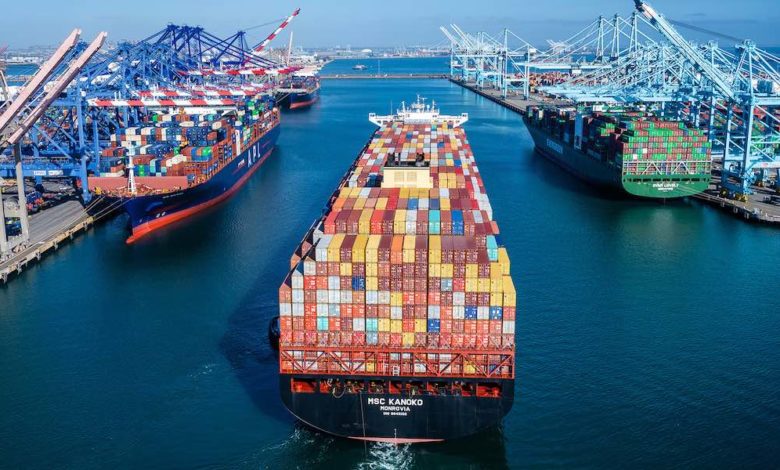White House repeats concerns about liner monopoly situation

The White House has reiterated its concerns at the monopoly the three global liner alliances have on imports and exports to and from the world’s largest economy.
With the country racked by supply chain issues all year, the government has been taking many measures to try and alleviate the container crunches seen at ports and inland depots, which has seen costs for retailers and exporters spiral in 2021.
In a blog post on the White House website, the Biden administration hit out at the lack of competition among containerlines. The three liner groupings – 2M, Ocean Alliance and THE Alliance – control about 80% of the global liner shipping market and 95% on the East-West trade lanes, the post pointed out, reminding readers that alliances only controlled 29% of the market as recently as 2011.
“This lack of competition leaves American businesses at the mercy of just three alliances,” the blog post stated.
This lack of competition leaves American businesses at the mercy of just three alliances
“Retailers are charged fees for their container remaining on the docks, even if there is no way to move their containers. If the alliances decide to not accept exports, agricultural exporters will not be able to fulfill their contracts, and farmers’ perishable products may be left to rot,” the missive from the White House suggested.
In July, president Biden called attention to these problems in his executive order on promoting competition in the American economy, which encouraged the Federal Maritime Commission (FMC) to enforce the prohibition against ocean carriers charging unfair fees to exporters and importers.
“The Federal Maritime Commission, which has jurisdiction to regulate the carriers, should use all of the tools at its disposal to ensure free and fair competition,” the White House stressed again this week. The FMC has already launched an inquiry into excessive shipping fees that are charged when the importer or exporter cannot plausibly move the container.
This is not the fault of any given supply chain actor
The White House said this week that the FMC should consider using its other tools, too, with the Justice Department on hand to lend the shipping regulator support. For example, while the alliances between the carriers receive statutory immunity from antitrust laws, the FMC can challenge those agreements if they “produce an unreasonable reduction in transportation service or an unreasonable increase in transportation cost or … substantially lessen competition.”
The White House also urged for Congress to help out too by expanding the FMC’s $30m annual budget.
Current laws do not require even basic transparency in liner shipping, the White House argued. For example, there is no public reporting of the detention and demurrage fees carriers are charging their customers.
The post from Washington DC has elicited plenty of comment. One of liner shipping’s top commentators, Lars Jensen from consultancy Vespucci Maritime, hit out at some of the statistical inaccuracies in the article.
“It is problematic when policy makers appear to base their opinions on outdated information which is misleading in terms of the realities on the ground,” Jensen wrote in a post on LinkedIn today, pointing out that the 95% stat mentioned pertaining to the global carriers’ hold on the main east-west trades is incorrect, especially on the transpacific where the number of non-alliance carriers has risen to 30% of the market during 2021.
Liner shipping – on track to record its greatest profits in history amid the box delivery chaos – has repeatedly sought to lay the blame for this year’s supply chain woes at the feet of other parts of the economy.
The World Shipping Council, the Washington DC-based liner lobbying group, has repeatedly argued that all parts of the supply chain are facing unprecedented pressures.
“There is a lack of rail and truck capacity, warehouses are full, and ports are bursting at the seams,” the WSC observed in a release from July.
“This is not the fault of any given supply chain actor. Supply chains simply cannot efficiently handle this extreme demand surge, thus resulting in the delays, disruptions and capacity shortages felt across the chain. All supply chain players are working to clear the system, but the fact is that as long as the massive import demand from US businesses and consumers continues, the challenges will remain,” said John Butler, president and CEO of the WSC, going on to argue that liner shipping remains competitive.
Other nations, including China, Vietnam and South Korea, have also looked into tackling high shipping costs over the past year.

If there are three liner groups then this is an oligopoly, not a monopoly………Doesn’t Splash have a dictionary?
Which statement is more relevant and correct:
”The three liner groupings control about 95% on the East-West trade lanes………….” or
”the number of non-alliance carriers has risen to 30% of the market………”
I would venture to say the first statement is more relevant and correct because that is the statement explaining total cargo volume and market share. The second statement is about the number of lines and carriers serving the route, which is irrelevant because most of those are small independent carriers with very limited capacity and small ships (or even shipper groups serving themselves).
That is NOT a statistical inaccuracy – it is a mis-statement of the facts and relevant data.